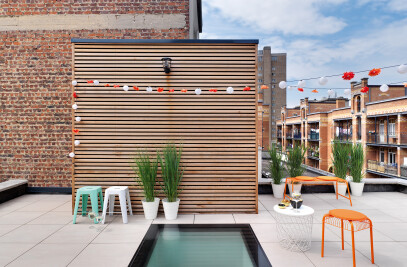LMN Architects, renowned for their approach to designing educational spaces, have completed the Undergraduate Academic Building at UC Berkeley. Located aon a prominent site framing the university's historic Campanile Way and Strawberry Creek green space, this building balances a new center of gravity for general education with a surrounding historic campus context. The design is defined by its mass timber structure and exposed wood elements.
The five-story building includes nods to the limestone plaster facades of the campus's classical core, clean lines, crisp cladding, and a series of covered arcades. A terrace framed by the L-shaped building and the grade-level auditorium below both take cues from the Strawberry Creek green space located just beyond, with an emphasis on organic forms, textures, and native plantings.
Inside, full-height windows bring in daylight, animating the interior of the mass timber structure. Outside, informal learning spaces provide opportunities for students to study, collaborate, and socialize.
Flexible Learning Spaces:
At the core of the Undergraduate Academic Building's design is flexibility. LMN Architects envisioned a space that would support various teaching methods, from traditional lectures to collaborative, project-based learning. Housing 27 classrooms and able to accommodate 1,300 students per hour, the building incorporates a variety of informal learning spaces, outdoor study areas, and open corridors, fostering intellectual exchange and collaboration among students.
The building prioritizes diversity, equity, and inclusion (DEI) principles and promotes social interaction and inclusive education. This includes innovative classroom elements, such as turn-to-team seating in the 400-seat lecture hall and a variety of classroom sizes.
Sustainability:
Embracing wood's biophilic benefits, this mass timber project significantly reduces its embodied carbon while also creating a warm and welcoming space throughout. Targeting LEED Gold, the all-electric building is PV-ready and includes energy-efficient features such as cross-ventilated classrooms, offices with operable windows and ceiling fans, exterior shading, and demand-control ventilation with heat recovery. The building is also equipped with a rainwater collection system.
Connectivity and Community:
The building's central location on campus enhances its accessibility, becoming a hub for undergraduate students from all disciplines. Further, its location and porosity of the building allow it to function in effect as a bridge between the campus's academic core and the student life facilities across the creek. LMN Architects' focus on connectivity extends to the digital infrastructure as well, with robust technology integrated throughout the building to support digital learning and remote collaboration.
LMN Architects' design of UC Berkeley's Undergraduate Academic building reflects a modern approach to education while respecting the university's historical roots. By creating flexible learning spaces, prioritizing sustainability, and fostering community, the building stands as a testament to Berkeley's vision for the future of education. It is not only an architectural landmark but a symbol of the university's ongoing commitment to providing an exceptional undergraduate experience.















































